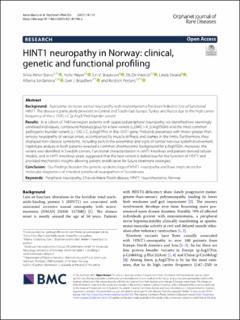| dc.contributor.author | Høyer, Helle | |
| dc.contributor.author | Amor-Barris, Silvia | |
| dc.contributor.author | Brauteset, Lin | |
| dc.contributor.author | De Vriendt, Els | |
| dc.contributor.author | Strand, Linda | |
| dc.contributor.author | Jordanova, Albena | |
| dc.contributor.author | Braathen, Geir Julius | |
| dc.contributor.author | Peeters, Kristien | |
| dc.date.accessioned | 2024-03-13T12:46:24Z | |
| dc.date.available | 2024-03-13T12:46:24Z | |
| dc.date.created | 2021-03-25T13:44:53Z | |
| dc.date.issued | 2021 | |
| dc.identifier.citation | Orphanet Journal of Rare Diseases. 2021, 16 (1):116. | en_US |
| dc.identifier.issn | 1750-1172 | |
| dc.identifier.uri | https://hdl.handle.net/11250/3122146 | |
| dc.description.abstract | Background: Autosomal recessive axonal neuropathy with neuromyotonia has been linked to loss of functional HINT1. The disease is particularly prevalent in Central and South-East Europe, Turkey and Russia due to the high carrier frequency of the c.110G > C (p.Arg37Pro) founder variant. Results: In a cohort of 748 Norwegian patients with suspected peripheral neuropathy, we identified two seemingly unrelated individuals, compound heterozygous for a new variant (c.284G > A, p.Arg95Gln) and the most common pathogenic founder variant (c.110G > C, p.Arg37Pro) in the HINT1 gene. Probands presented with motor greater than sensory neuropathy of various onset, accompanied by muscle stiffness and cramps in the limbs. Furthermore, they displayed non-classical symptoms, including pain in the extremities and signs of central nervous system involvement. Haplotype analysis in both patients revealed a common chromosomal background for p.Arg95Gln; moreover, the variant was identified in Swedish carriers. Functional characterization in HINT1-knockout and patient-derived cellular models, and in HNT1-knockout yeast, suggested that the new variant is deleterious for the function of HINT1 and provided mechanistic insights allowing patient stratification for future treatment strategies. Conclusion: Our findings broaden the genetic epidemiology of HINT1-neuropathy and have implications for molecular diagnostics of inherited peripheral neuropathies in Scandinavia. | en_US |
| dc.description.sponsorship | This study was funded by the following funding agencies: Research Foundation-Flanders (FWO): Research Grant #G049217N (to A.J.); postdoctoral fellowship to K.P.; pre-doctoral fellowship to S.A.B. South Eastern Norway Regional Health Authority (HSØ): Research Grant #2016133; postdoctoral fellowship to H.H. None of the funding agencies were directly involved in this study. | en_US |
| dc.language.iso | eng | en_US |
| dc.publisher | BMC | en_US |
| dc.relation.uri | https://www.ncbi.nlm.nih.gov/pmc/articles/PMC7934415/pdf/13023_2021_Article_1746.pdf | |
| dc.rights | Navngivelse 4.0 Internasjonal | * |
| dc.rights.uri | http://creativecommons.org/licenses/by/4.0/deed.no | * |
| dc.subject | Charcot-Marie-Tooth disease | en_US |
| dc.subject | HINT1 | en_US |
| dc.subject | Neuromyotonia | en_US |
| dc.subject | Norway | en_US |
| dc.subject | Peripheral neuropathy | en_US |
| dc.title | HINT1 neuropathy in Norway: clinical, genetic and functional profiling | en_US |
| dc.type | Peer reviewed | en_US |
| dc.type | Journal article | en_US |
| dc.description.version | publishedVersion | en_US |
| dc.rights.holder | © The Author(s) 2021. This article is licensed under a Creative Commons Attribution 4.0 International License, which permits use, sharing, adaptation, distribution and reproduction in any medium or format, as long as you give appropriate credit to the original author(s) and the source, provide a link to the Creative Commons licence, and indicate if changes were made. The images or other third party material in this article are included in the article's Creative Commons licence, unless indicated otherwise in a credit line to the material. If material is not included in the article's Creative Commons licence and your intended use is not permitted by statutory regulation or exceeds the permitted use, you will need to obtain permission directly from the copyright holder. To view a copy of this licence, visit http://creativecommons.org/licenses/by/4.0/. The Creative Commons Public Domain Dedication waiver (http://creativecommons.org/publicdomain/zero/1.0/) applies to the data made available in this article, unless otherwise stated in a credit line to the data. | en_US |
| dc.source.pagenumber | 11 | en_US |
| dc.source.volume | 16 | en_US |
| dc.source.journal | Orphanet Journal of Rare Diseases | en_US |
| dc.source.issue | 1 | en_US |
| dc.identifier.doi | 10.1186/s13023-021-01746-z | |
| dc.identifier.cristin | 1901051 | |
| cristin.ispublished | true | |
| cristin.fulltext | original | |
| cristin.qualitycode | 1 | |

